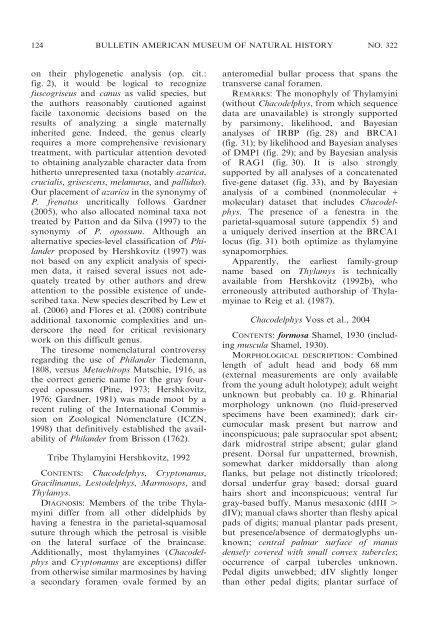phylogenetic relationships and classification of didelphid marsupials ...
phylogenetic relationships and classification of didelphid marsupials ...
phylogenetic relationships and classification of didelphid marsupials ...
Create successful ePaper yourself
Turn your PDF publications into a flip-book with our unique Google optimized e-Paper software.
124 BULLETIN AMERICAN MUSEUM OF NATURAL HISTORY NO. 322<br />
on their <strong>phylogenetic</strong> analysis (op. cit.:<br />
fig. 2), it would be logical to recognize<br />
fuscogriseus <strong>and</strong> canus as valid species, but<br />
the authors reasonably cautioned against<br />
facile taxonomic decisions based on the<br />
results <strong>of</strong> analyzing a single maternally<br />
inherited gene. Indeed, the genus clearly<br />
requires a more comprehensive revisionary<br />
treatment, with particular attention devoted<br />
to obtaining analyzable character data from<br />
hitherto unrepresented taxa (notably azarica,<br />
crucialis, grisescens, melanurus, <strong>and</strong> pallidus).<br />
Our placement <strong>of</strong> azarica in the synonymy <strong>of</strong><br />
P. frenatus uncritically follows Gardner<br />
(2005), who also allocated nominal taxa not<br />
treated by Patton <strong>and</strong> da Silva (1997) to the<br />
synonymy <strong>of</strong> P. opossum. Although an<br />
alternative species-level <strong>classification</strong> <strong>of</strong> Phil<strong>and</strong>er<br />
proposed by Hershkovitz (1997) was<br />
not based on any explicit analysis <strong>of</strong> specimen<br />
data, it raised several issues not adequately<br />
treated by other authors <strong>and</strong> drew<br />
attention to the possible existence <strong>of</strong> undescribed<br />
taxa. New species described by Lew et<br />
al. (2006) <strong>and</strong> Flores et al. (2008) contribute<br />
additional taxonomic complexities <strong>and</strong> underscore<br />
the need for critical revisionary<br />
work on this difficult genus.<br />
The tiresome nomenclatural controversy<br />
regarding the use <strong>of</strong> Phil<strong>and</strong>er Tiedemann,<br />
1808, versus Metachirops Matschie, 1916, as<br />
the correct generic name for the gray foureyed<br />
opossums (Pine, 1973; Hershkovitz,<br />
1976; Gardner, 1981) was made moot by a<br />
recent ruling <strong>of</strong> the International Commission<br />
on Zoological Nomenclature (ICZN,<br />
1998) that definitively established the availability<br />
<strong>of</strong> Phil<strong>and</strong>er from Brisson (1762).<br />
Tribe Thylamyini Hershkovitz, 1992<br />
CONTENTS: Chacodelphys, Cryptonanus,<br />
Gracilinanus, Lestodelphys, Marmosops, <strong>and</strong><br />
Thylamys.<br />
DIAGNOSIS: Members <strong>of</strong> the tribe Thylamyini<br />
differ from all other <strong>didelphid</strong>s by<br />
having a fenestra in the parietal-squamosal<br />
suture through which the petrosal is visible<br />
on the lateral surface <strong>of</strong> the braincase.<br />
Additionally, most thylamyines (Chacodelphys<br />
<strong>and</strong> Cryptonanus are exceptions) differ<br />
from otherwise similar marmosines by having<br />
a secondary foramen ovale formed by an<br />
anteromedial bullar process that spans the<br />
transverse canal foramen.<br />
REMARKS: The monophyly <strong>of</strong> Thylamyini<br />
(without Chacodelphys, from which sequence<br />
data are unavailable) is strongly supported<br />
by parsimony, likelihood, <strong>and</strong> Bayesian<br />
analyses <strong>of</strong> IRBP (fig. 28) <strong>and</strong> BRCA1<br />
(fig. 31); by likelihood <strong>and</strong> Bayesian analyses<br />
<strong>of</strong> DMP1 (fig. 29); <strong>and</strong> by Bayesian analysis<br />
<strong>of</strong> RAG1 (fig. 30). It is also strongly<br />
supported by all analyses <strong>of</strong> a concatenated<br />
five-gene dataset (fig. 33), <strong>and</strong> by Bayesian<br />
analysis <strong>of</strong> a combined (nonmolecular +<br />
molecular) dataset that includes Chacodelphys.<br />
The presence <strong>of</strong> a fenestra in the<br />
parietal-squamosal suture (appendix 5) <strong>and</strong><br />
a uniquely derived insertion at the BRCA1<br />
locus (fig. 31) both optimize as thylamyine<br />
synapomorphies.<br />
Apparently, the earliest family-group<br />
name based on Thylamys is technically<br />
available from Hershkovitz (1992b), who<br />
erroneously attributed authorship <strong>of</strong> Thylamyinae<br />
to Reig et al. (1987).<br />
Chacodelphys Voss et al., 2004<br />
CONTENTS: formosa Shamel, 1930 (including<br />
muscula Shamel, 1930).<br />
MORPHOLOGICAL DESCRIPTION: Combined<br />
length <strong>of</strong> adult head <strong>and</strong> body 68 mm<br />
(external measurements are only available<br />
from the young adult holotype); adult weight<br />
unknown but probably ca. 10 g. Rhinarial<br />
morphology unknown (no fluid-preserved<br />
specimens have been examined); dark circumocular<br />
mask present but narrow <strong>and</strong><br />
inconspicuous; pale supraocular spot absent;<br />
dark midrostral stripe absent; gular gl<strong>and</strong><br />
present. Dorsal fur unpatterned, brownish,<br />
somewhat darker middorsally than along<br />
flanks, but pelage not distinctly tricolored;<br />
dorsal underfur gray based; dorsal guard<br />
hairs short <strong>and</strong> inconspicuous; ventral fur<br />
gray-based buffy. Manus mesaxonic (dIII .<br />
dIV); manual claws shorter than fleshy apical<br />
pads <strong>of</strong> digits; manual plantar pads present,<br />
but presence/absence <strong>of</strong> dermatoglyphs unknown;<br />
central palmar surface <strong>of</strong> manus<br />
densely covered with small convex tubercles;<br />
occurrence <strong>of</strong> carpal tubercles unknown.<br />
Pedal digits unwebbed; dIV slightly longer<br />
than other pedal digits; plantar surface <strong>of</strong>

















